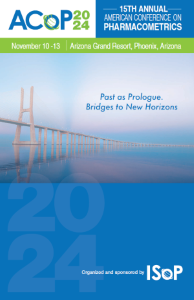QSP
(T-010) A quantitative systems pharmacology model framework for combined clinical efficacy and hematological toxicity predictions for antibody drug conjugates
Tuesday, November 12, 2024
7:00 AM - 5:00 PM MST
Raunak Dutta, B Tech – Senior Scientist, Vantage Research; Swagatika Sahoo, Ph. D. – Senior Scientist, Vantage Research; Rukmini Kumar, Ph. D. – CSO, Vantage Research
- BP
Bhairav Paleja, Ph. D.
Lead Scientist
Vantage Research, India 
Dinesh B. Bedathuru (he/him/his)
Lead Scientist
Vantage Research
Natick, Massachusetts, United States
Author(s)
Presenter(s)
Disclosure(s):
Dinesh B. Bedathuru: No financial relationships to disclose
Objectives: Antibody-drug conjugates (ADCs) signify a major leap forward in cancer treatment, providing a precise method to deliver potent cytotoxic drugs directly to cancer cells. Understanding and analyzing various aspects of ADCs are crucial for making well-informed decisions during the development of these groundbreaking medications. Although ADCs are generally well tolerated by patients, certain treatment-related adverse events are commonly reported and lead to patient discontinuation. Dose-limiting toxicities (DLTs) are frequently observed across various antibody-drug conjugates (ADCs) that administer the same cytotoxic payload, regardless of the targeted antigen or the specific type of cancer being treated. Here we outline a quantitative systems pharmacology (QSP) model framework developed to predict both clinical efficacy and hematological toxicity for antibody drug conjugates.
Methods: In the current work we have utilized a previously reported (1), QSP ADC model as the base model. This model comprehensively represents both the cellular and systemic dynamics of drug disposition, taking into account both drug and target antigen related properties such as expression of the target antigen, formation of drug-antigen complexes and their internalization. Additionally, the model integrates modules to simulate drug distribution within a tumor, inhibition of tumor growth and the phenomenon of bystander effect induced by the drug. For capturing ADC payload induced hematological toxicity (namely thrombocytopenia), a pharmacodynamics (PD) model of chemotherapy induced myelosuppression was repurposed (2,3). The model was informed and calibrated with in-vivo preclinical and clinical data for Trastuzumab emtansine, and used for clinical therapeutic index and alternate dosing strategy predictions.
Results: The developed model effectively captured in-vivo preclinical PK and efficacy data for Trastuzumab emtansine (4). The model output for translation to humans accurately described clinical response in terms of tumor growth inhibition (5). In addition, the model predicted platelet dynamics in response to payload concentration mirrored published data (6).
Conclusions: The QSP model framework described here can be utilized for effective prediction of efficacy and toxicity for ADCs. The model can be used to determine dosing regimen and therapeutic window. Given availability of data, the model can be used for informing translation and early clinical development of novel ADCs.
Citations: [1] Channavazzala M, et al. Development of a mechanistic mPBPK/QSP Antibody drug conjugates (ADC) platform model with applications across preclinical, translational and clinical stages of drug development. ACoP13 (2022) QSP-427
[2] Friberg LE, et al. Model of chemotherapy-induced myelosuppression with parameter consistency across drugs. J Clin Oncol. 2002 Dec 15;20(24):4713-21. doi: 10.1200/JCO.2002.02.140.
[3] Ait-Oudhia S, et al. A Mechanism-Based PK/PD Model for Hematological Toxicities Induced by Antibody-Drug Conjugates. AAPS J. 2017 Sep;19(5):1436-1448. doi: 10.1208/s12248-017-0113-5
[4] Haddish-Berhane N, et al. On translation of antibody drug conjugates efficacy from mouse experimental tumors to the clinic: a PK/PD approach. J Pharmacokinet Pharmacodyn. 2013 Oct;40(5):557-71. doi: 10.1007/s10928-013-9329-x
[5] Burris HA 3rd, et al. Phase II study of the antibody drug conjugate trastuzumab-DM1 for the treatment of human epidermal growth factor receptor 2 (HER2)-positive breast cancer after prior HER2-directed therapy. J Clin Oncol. 2011 Feb 1;29(4):398-405. doi: 10.1200/JCO.2010.29.5865
[6] Bender BC,et al. A population pharmacokinetic/pharmacodynamic model of thrombocytopenia characterizing the effect of trastuzumab emtansine (T-DM1) on platelet counts in patients with HER2-positive metastatic breast cancer. Cancer Chemother Pharmacol. 2012 Oct;70(4):591-601. doi: 10.1007/s00280-012-1934-7

